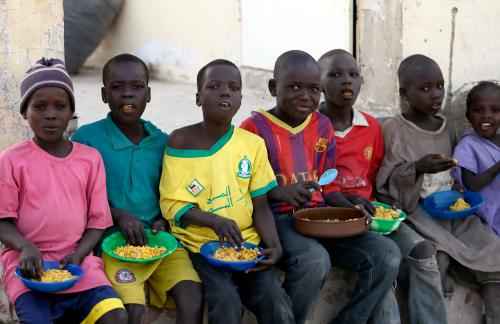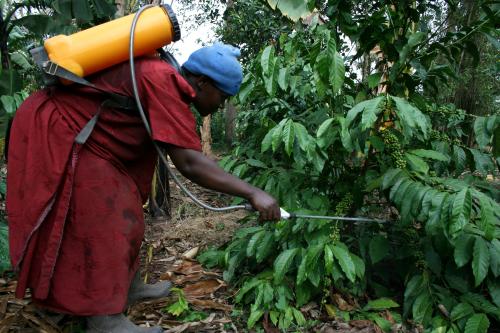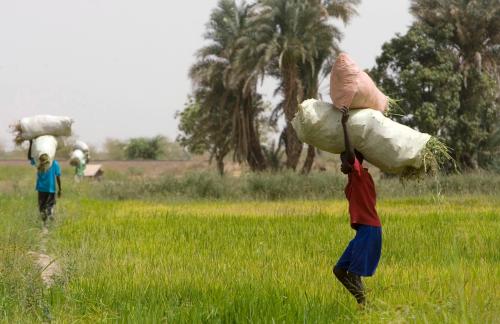This blog is one of a six-part series celebrating World Food Day and highlighting the particular food and nutrition security challenges faced by African nations through six case studies in the Brookings Global Ending Rural Hunger project. The findings summarized below can be found in more depth in the Ending Rural Hunger Tanzania case study. The other case study countries include Uganda, Ghana, Nigeria, Senegal, and Ethiopia.
Ending hunger, an ambition enshrined in the Sustainable Development Goals (SDG), specifically SDG2, which focuses on ending hunger, achieving food security, improving nutrition, and promoting sustainable agriculture by 2030.
In Tanzania, where more than 67 percent of the total population lives in rural areas and reliance on agriculture and agriculture-related activities is a vital source of employment, food is a matter of life and death. And this population is under a high nutrition deficit: Nearly three-quarters of the country’s undernourished and 80 percent of its hungry are found there. By mapping the specific food and nutrition security (FNS) needs and policies in Tanzania, the Ending Rural Hunger (ERH) project identifies gaps and recommends policies for achieving FNS.
Food and nutrition security gaps in Tanzania
Low access to food, high nutritional needs, the agricultural productivity gap, and vulnerability to environmental shocks are the most salient problems facing Tanzania’s rural population. A significant proportion of rural people suffer from undernourishment (39.3 percent), a low average dietary energy intake (33.9 percent), and poverty (26.7 percent). The ERH database shows undernourishment in the country to be even higher than the government’s statistic (81 percent) (Figure 1). Even though Tanzania is food self-sufficient at the national level, food is not accessible to all. Indeed, 34 percent of the population is not able to meet daily caloric requirements. The reasons for this low supply include poverty—Tanzania has high rural poverty and multidimensional poverty rates (Figure 1)—logistical barriers due to poor road networks, and low productivity due to drought, disease, inadequate inputs, and rudimentary technology.
 Equally important, Tanzania is also nutrition insecure. Poor availability of diversified foods and poor food utilization due to low nutrition knowledge confront the country’s rural population. As a result, high rates of malnutrition are observed, especially among children under five, leading to above-average national malnutrition rates compared to other countries in the region. According to the ERH database, Tanzania receives a score of 90—where 100 represents the greatest need—on average protein supply needs and 59 on calories extracted from staples as a percentage of total energy supply. Furthermore, under-five stunting and anemia in children are also prevalent in Tanzania (Figure 2).
Equally important, Tanzania is also nutrition insecure. Poor availability of diversified foods and poor food utilization due to low nutrition knowledge confront the country’s rural population. As a result, high rates of malnutrition are observed, especially among children under five, leading to above-average national malnutrition rates compared to other countries in the region. According to the ERH database, Tanzania receives a score of 90—where 100 represents the greatest need—on average protein supply needs and 59 on calories extracted from staples as a percentage of total energy supply. Furthermore, under-five stunting and anemia in children are also prevalent in Tanzania (Figure 2).
Micronutrient deficiencies cost the country around 2.65 percent of GDP (equivalent to $518 million every year). Deficiencies—especially in iron and vitamin A—are highest among women of reproductive age (between 15-49 years) and children under five. In line with findings from the ERH database, 58 percent of children and 45 percent of women are anemic; and 33 percent and 37 percent of children and women, respectively, are deficient in vitamin A.
In terms of agricultural production, the country performs poorly compared to the rest of sub-Saharan Africa, especially in cereal productivity, labor productivity, and the ratio in which agricultural land is allocated to family farms. These poor performances often stem from a number of factors, including low investment in research and development and high dependence on rudimentary technology (around 70 percent of Tanzanians still depend on hand hoes for cultivating their crops). Another factor at play is the poor access to improved seeds and fertilizer; in 2016/17 the use of fertilizer was around 19 kilograms per hectare, a rate below the 50 kg/hectare set by the Comprehensive Africa Agriculture Development Program (CAADP). A third influential factor is poor access to finance in agriculture-related activities; only 8.5 percent of rural households have accessed agricultural loans in recent years.
Regarding vulnerability to environmental shocks, the country faces relatively fewer risks compared to other countries in the region, owing to the fact that the country is endowed with water bodies suitable for irrigation. However, this opportunity is largely unexploited, as much of the agriculture is rain fed (90 percent), and only 450,392 hectares out of 29.4 million hectares of land with the potential for irrigation are actually under irrigation—a situation that exposes the country to volatility in agricultural production and cereal crop yields.
Adequacy of country policies to address food and nutrition needs
Assessing the role of Tanzania’s policies in addressing its food and nutrition security needs is an important aspect of tracking the country’s progress in achieving SDG2. Tanzania does not have a strategy that is solely aimed at achieving SDG2, but rather its strategies are fragmented and embedded in various national and development policies and programs. These strategies can be seen in the Tanzania Development Vision (TDV 2025), which is implemented in five year phases; CAADP, which translates to the Food Security Development Plan (TAFSIP); ASDPI and II; the National Multi-sectoral Nutrition Action Plan (NMNAP), District Agricultural Development Plans (DADPs), Land Tenure Support Programme (LTSP), and the Southern Agricultural Growth Corridor of Tanzania (SAGCOT).
Despite the efforts to address the country’s poverty, food and nutrition security, and agriculture productivity, current needs are not being met. In-depth interviews with stakeholders identified a mismatch between policy formulation and actual implementation; poor coordination among agriculture-related ministries and between regulatory bodies; and insufficient resource allocation and commitment. Government allocation of resources is also small—many of the agriculture development strategies and programs are donor funded. Other explanations for the large gaps are related to poor infrastructure development—particularly roads, electricity, and irrigation—and low-quality human resources (unskilled labor and low technical know-how).
While many factors contribute to reaching SDG2 by 2030, some interviewees in the Tanzania ERH case study felt that, to be able to close the gaps, the government needs to operate like the private sector (i.e., be profit-oriented) and allow business to drive the agriculture sector.
recommendations
Although Tanzania has a number of strong strategies, programs, and policies relevant for combating rural poverty, hunger, and food and nutrition insecurity, the country has yet to close the gaps and reach SDG2 by 2030. To do so, the Tanzania ERH case study recommends six priority areas:
First, the country must increase access to food and nutrition through:
- Food distribution by investing in good road networks;
- Education campaigns on food quality/utilization as well as an emphasis on the importance of the different food groups in diets (especially for pregnant women and children);
- And social marketing to farmers and small-scale food processors on the importance of supplying nutritious foods through fortification, soil nutrition, and growing bio-fortified crops and different food groups.
Second, Tanzania should aim to reduce vulnerability to environmental shocks in rural areas by increasing the capacity of small-holder farmers to exploit the vast irrigation potential available in the country.
Third, the government and development partners should commit more resources in activities/programs/infrastructure related to boosting agricultural growth.
Fourth, the pace of policy reforms should go hand-in-hand with changes in other issues affecting the economy like demographic changes, climate change, urbanization, and changes in the income distribution.
Fifth, there should be improved coordination and complementarity between related ministries, donor projects, NGOs and between regulatory authorities in the agri-food systems.
Sixth, Tanzania should ensure an up-to-date implementation plan, including regular monitoring and evaluation of the stated plan/programs/strategies and policies.






Commentary
Addressing the mismatch between food and nutrition policies and needs in Tanzania
October 26, 2017